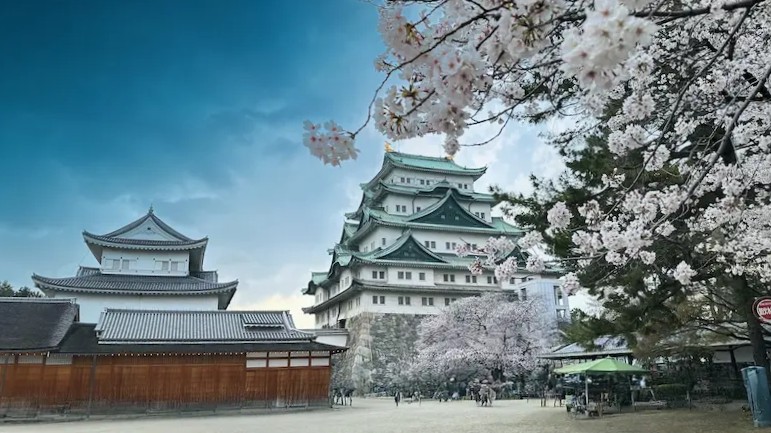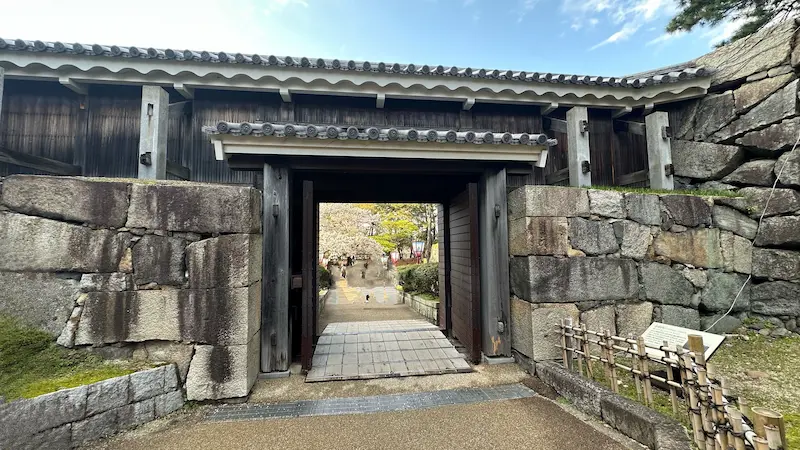Exploring the Historic Gates and Main Keep of Nagoya Castle
Nagoya Castle is home to a variety of historical gates and its iconic main keep, each with a unique architectural style and historical significance. From the original “Former Ninomaru East Second Gate” that dates back to the castle’s early days, to the reconstructed “Akazu no Mon (Fumeimon)” and the restored “Tenshukaku (Main Keep)”—rebuilt after wartime destruction—each location offers a glimpse into the enduring prestige of the Tokugawa clan. Let’s walk through these historic landmarks and experience the legacy of Nagoya Castle.
Former Ninomaru East Second Gate

🏛 Overview
The Former Ninomaru East Second Gate (Kyū-Ninomaru Higashi-Nino-mon) is a Kōraimon-style gate built around 1612 (Keichō 17). It was originally located on the eastern side of the Ninomaru compound, serving as a key entryway. In 1972, the gate was relocated to the site of the Honmaru East Second Gate, where it stands today.
One of the few structures to survive World War II air raids, it was designated an Important Cultural Property in 1975.
🗺 Address
1-1 Honmaru, Naka Ward, Nagoya, Aichi Prefecture
🚶 Access
About a 1-minute walk (20m) from Kiyomasa Stone.
⏳ Suggested Visit Duration
- Quick Stop: Approx. 10 minutes (for viewing the exterior and surroundings)
- In-depth Tour: Approx. 20 minutes (for examining the structure and history, plus photo ops)
📍 Highlights
- Kōraimon Structure: Known for its sturdy design with main and auxiliary pillars, this gate represents classic castle architecture from the Sengoku era.
- Relocation History: The move from its original location is a testament to efforts in historical preservation.
- Seasonal Beauty: Cherry blossoms in spring frame the gate with stunning elegance.
📌 Trivia
- Hidden Historical Role: As one of the few original structures, it offers rare insight into the original layout of Nagoya Castle.
- Little-Known Fact: Its relocation in 1972 resulted in excellent preservation, allowing for close observation of period construction techniques.
- Connection to History: Built as part of Tokugawa Ieyasu’s grand castle project.
Karame-te Umadashi Remains(Backstreets of the Horse Riding)

🏛 Overview
Located in the northeastern corner of the main compound, the Karame-te Umadashi Remains once served as a defensive stronghold for the castle’s rear gate (Karame-te-mon). An umadashi is a small semi-circular or square enclosure designed to slow enemy advances and facilitate the castle’s defense.
This particular umadashi bolstered defenses on the castle’s eastern side and played a crucial role in protecting the main keep from direct assault.
Due to aging and potential collapse risks, restoration efforts began in 2004. As of 2023, full-scale stone wall repairs are underway—making this one of the castle’s most significant renovation projects.
🗺 Address
1-1 Honmaru, Naka Ward, Nagoya, Aichi Prefecture (Karame-te Umadashi Remains)
🚶 Access
Approx. 1-minute walk (20m) from the Former Ninomaru East Second Gate. Note: Currently closed to the public.
⏳ Suggested Visit Duration
- Quick Stop: Approx. 10 minutes
- In-depth Tour: Approx. 20 minutes (for detailed viewing of the stone walls and photos)
📍 Highlights
- Stone Wall Restoration: Visitors can observe traditional stone masonry techniques in action.
- Umadashi Design: The structure offers insights into wartime castle defense strategies.
- Seasonal Beauty: The cherry blossoms in spring create a captivating contrast with the historic stonework.
📌 Trivia
- Strategic Importance: This defensive feature supported both protection and tactical counterattacks from within the castle.
- Hidden Details: Restoration revealed daimyo seals and inscriptions on the stones, providing a direct link to the castle’s original builders.
- Historical Ties: Tokugawa Ieyasu enlisted feudal lords nationwide in the construction of Nagoya Castle, and their mark remains on the stones here.
Tenshukaku (Main Keep)

🏛 Overview
The Main Keep of Nagoya Castle was completed in 1612 as a five-story structure embodying the pinnacle of early Edo-period architecture and Tokugawa authority. Its roof famously featured golden shachihoko (mythical tiger-headed carp), earning the castle the nickname Kinshachi-jō (“Golden Dolphin Castle”) and establishing it as the symbol of the Owari Tokugawa clan.
The original structure was destroyed during the 1945 air raids, and a reinforced concrete reconstruction was completed in 1959. After 60 years, structural aging and seismic concerns led to the building’s closure.
🗺 Address
1-1 Honmaru, Naka Ward, Nagoya, Aichi Prefecture
🚶 Access
Approx. 2-minute walk (150m) from the Former Ninomaru East Second Gate.
⏳ Suggested Visit Duration
- Quick Stop: Approx. 10 minutes
- In-depth Tour: Approx. 30 minutes
📍 Highlights
- Main Keep Exterior: The glimmering golden shachihoko atop the structure remain a beloved symbol of Nagoya.
- Honmaru Palace: Located nearby, it features lavish interior décor showcasing the artistry of the Edo period.
- Seasonal Attractions: Enjoy cherry blossoms in spring and colorful leaves in autumn framing the majestic keep.
📌 Trivia
- National Recognition: In 1930, the original keep became Japan’s first designated National Treasure under castle structures.
- Hidden Insight: The rebuilt keep served as a museum until its closure due to seismic risks.
- Historical Ties: Like other parts of the castle, the main keep was constructed under Tokugawa Ieyasu’s command.
Akazu no Mon (Fumeimon)

🏛 Overview
Located on the northern edge of the main compound, Akazu no Mon—translated as “The Sealed Gate”—was a secret entrance to the inner chambers of the Honmaru Palace. It is a type of Uzumimon (concealed gate), once tightly locked at all times, hence the name.
Built beneath the Tammonbei (corridor wall), the gate was further secured by Kenbei (spearhead palisades) on both sides. Destroyed during WWII, the gate was faithfully reconstructed in 1978.
🗺 Address
1-1 Honmaru, Naka Ward, Nagoya, Aichi Prefecture (North of Honmaru)
🚶 Access
Approx. 1-minute walk (40m) from the Small Keep (Koten-shukaku)
⏳ Suggested Visit Duration
- Quick Stop: Approx. 3 minutes
- In-depth Tour: Approx. 15 minutes
📍 Highlights
- Gate Structure: This hidden gate beneath a long corridor wall offers a rare architectural form within the castle.
- Kenbei Palisade: Unique spear-tipped fencing on either side highlights its defensive role.
- Seasonal Scenery: Cherry blossoms and autumn foliage provide a breathtaking seasonal backdrop.
📌 Trivia
- Secret Function: This gate provided restricted access to the inner palace, used only by select individuals.
- Hidden Feature: The Kenbei fence is not seen elsewhere in the castle, adding to the uniqueness of this structure.
- Historical Connection: Constructed as part of Tokugawa Ieyasu’s grand vision for the castle.



comment